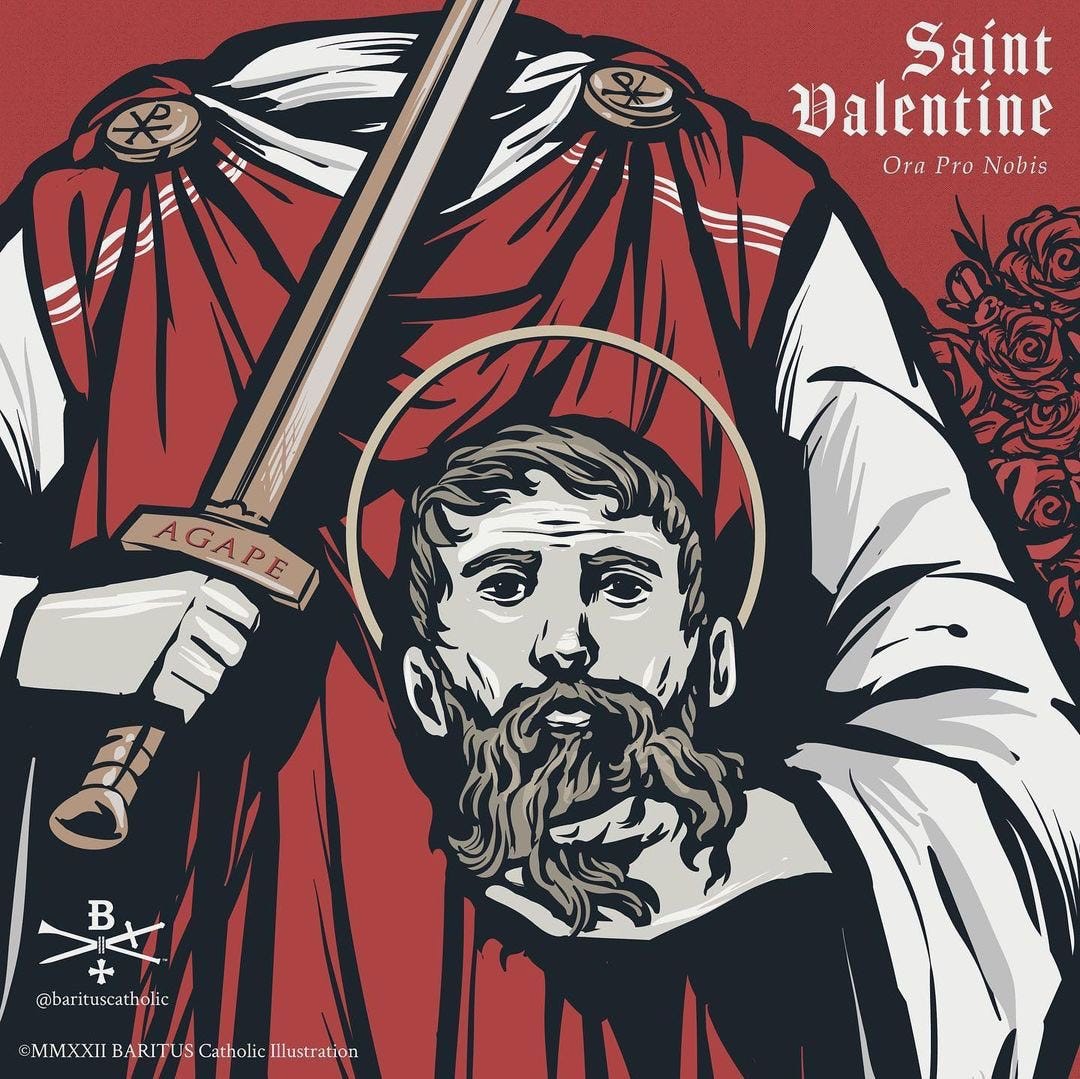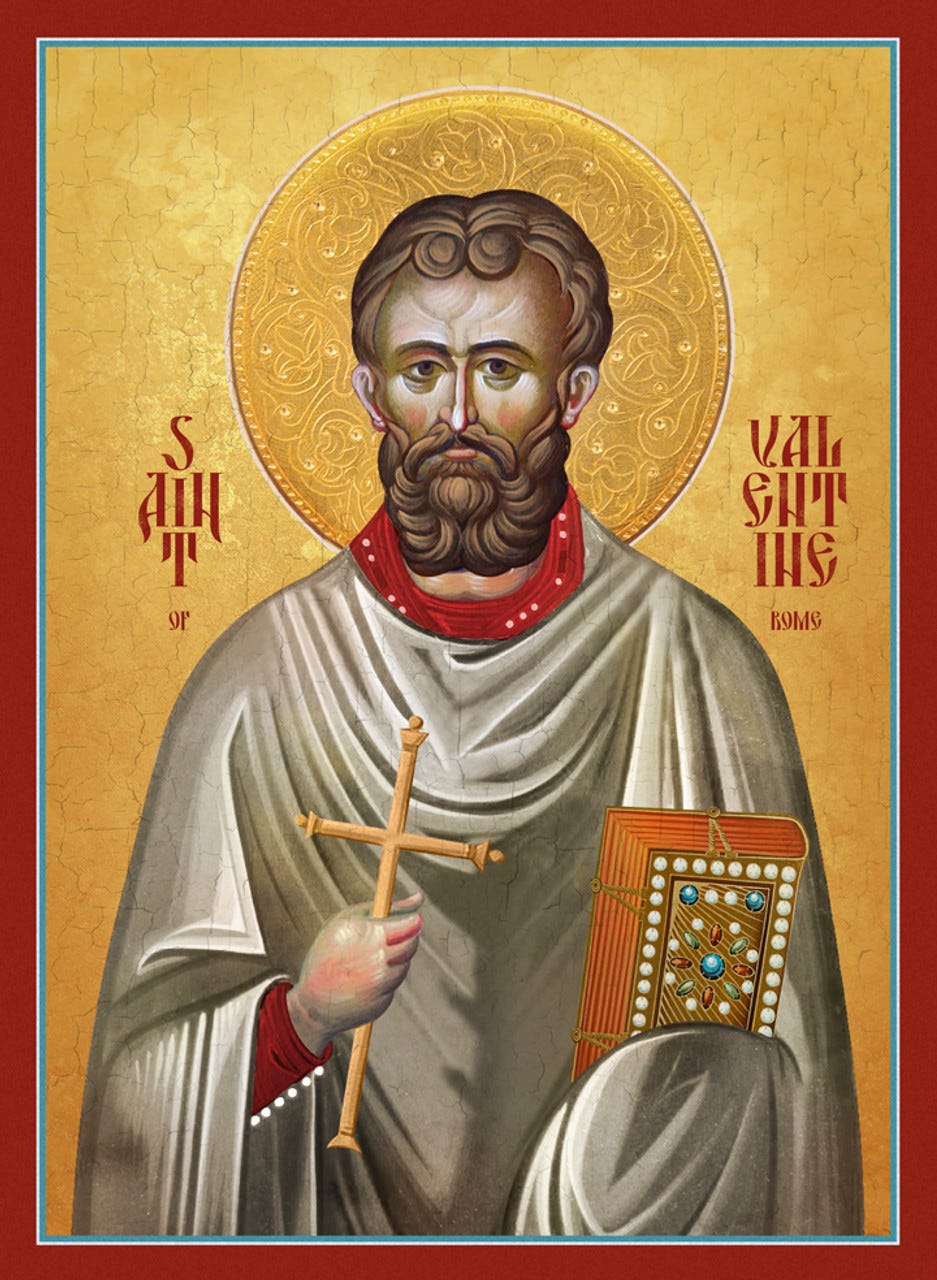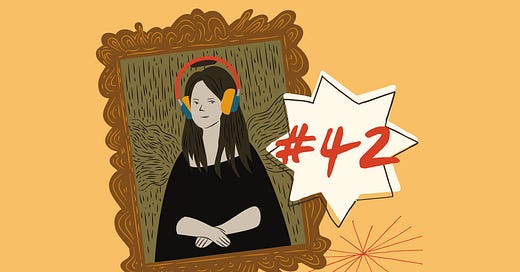Hello everyone,
Hope you all enjoyed the bonus episode I shared with you yesterday. Like Sunday’s History in the News post, I got really into the Valentine’s Day theme for this week’s episode, and I’m excited to share it with you all.
While you’re here, don’t forget to preorder my book, Unruly Figures: Twenty Tales of Rebels, Rulebreakers, and Revolutionaries, out on March 5!
🎙️ Transcript
We usually think of Valentine’s Day as being about love and romance—chocolate-covered strawberries, champagne, and big gestures like holding a boombox over your head or getting down on one knee. But the history of the holiday starts with a saint, a man named Valentine—or so we think. And the tale is surprisingly bloody and rebellious.
Hey everyone, welcome to Unruly Figures, the podcast that celebrates history’s greatest rule-breakers. I’m your host, Valorie Castellanos Clark, and today I’m covering Saint Valentine, the man whom we’re shooting arrows into hearts for tomorrow—at least, theoretically. While his story is shrowded in legend, we know he became a saint because he rebelled against Roman rule, and the tale is worth remembering this week.
Before we jump into the tale of Saint Valentine and how he rebelled against a bloodthirsty Roman emperor, I first have to thank all of the paying subscribers on Substack whose patronage helps me make this podcast possible. This podcast wouldn’t still be going without you! If you like this show and want more of it, please become a paying subscriber over on Substack! When you upgrade, you’ll get access to exclusive content, merch, and behind-the-scenes updates on the upcoming Unruly Figures book. When you’re ready to do that, head over to unrulyfigures.substack.com
All right, let’s hop into it.
The man we know as Saint Valentine might actually be two men, and we know next to nothing about them. The Catholic Church’s official list of martyrs, The Roman Martyrology, lists 20 martyrs who are honored every February 14th and two of those martyrs are named Valentine. The first reads, quote,
At Rome, on the Flaminian road, in the time of the emperor Claudius, the birthday of blessed Valentine, priest and martyr, who after having cured and instructed many persons, was beaten with clubs and beheaded.1
If I’m understanding correctly, this Valentine was once referred to as a saint, but was removed from the list of saints and their feast days by Pope Paul VI’s order on February 14, 1969. It’s been more than 55 years, but some people within the Catholic Church are still very upset about this.
The second reads, quote,
At Teramo, St. Valentine, bishop and martyr, who was scourged, committed to prison, and as he remained unshaken in his faith, was taken out of his dungeon in the dead of night and beheaded by order of Placidus, prefect of the city.2
Some people claim these two men are actually the same man named Valentine, who performed miracles and healed people before being martyred. But for now, let’s take them one at a time.
The story of the first Valentine, the one martyred in Rome, was a Catholic priest in Rome in about 270 AD. The emperor of Rome at the time, Claudius Gothicus, was the first in a line of soldier-emperors, men who came to power through military success and were often noted for their brutality and cruelty. For instance, there’s a legend that Claudius once punched a horse’s teeth out, which, why?3 He is mostly remembered for his military exploits, but the Vatican tends to claim that he also persecuted early Christians, though there are not a lot of secular records that back that claim up.
Nevertheless, the story goes that Valentine was well-known in Rome, so Claudius Gothicus invited him to the palace so he could get to know this famous priest. He liked Valentine, but he wanted to convert him away from Christianity, so he enlisted the help of his friend Asterius, who was charged with using "mellifluous arguments" to convert the priest.4
Naturally, it didn’t work. When Father Valentine arrived at Asterius’s home, he healed his daughter’s blindness by praying over her. Won over by this miracle, Asterius and his family all converted to Christianity, enraging the emperor. He had Valentine arrested and tried to force him to renounce his faith. He refused, sending a final note from his prison to Asterius’s daughter, supposedly signed, quote, “from your Valentine.”5
Soon after, Claudius had him beaten, and beheaded, though what became of Asterius is left up to interpretation. Considering how bloodthirsty these tellings usually paint Claudius, I can’t imagine his fate was a happy one.

But, there’s not a lot of secular information to back this up. Instead, there’s a lot of secular information to refute it—Claudius Gothicus doesn’t seem to have paid any particular attention to early Christians. He was too busy with foreign wars—he was fighting on several fronts, including against the Goths in modern-day Germany and the Gauls in modern-day France. He was often away from Rome, and when he was home he spent his time free time wrestling, overseeing improvements to the city, and punching horses, I guess. Maybe this lack of evidence is why the Catholic Church removed this Valentine from the list in 1969.
So let’s look at the second Valentine, the one martyred at Teramo.
About 70 years after the first Valentine, in 346 or 347 AD, Valentine was the Bishop of a city named Terni, a city smack in the center of Italy, just a bit northeast of Rome. He was invited to Rome by a philosopher named Crato, who had a son who suffered from a very severe injury or deformity that caused him a lot of pain. Crato offered Valentine half of his wealth if Valentine could only heal the boy.

But the bishop claimed it was not money that would heal the boy, but faith: If Crato just converted to Christianity, his son would be healed. Valentine prayed over the boy, and he was miraculously healed. Like before, the whole family converted, as well as several of Crato’s students—one of whom was the son of the Prefect of Rome, Placidus. When he found out, Placidus was furious that his son had converted to Christianity, so he punished Valentine by having him arrested and secretly beheaded in the dead of night so the Christians in Rome couldn’t protest it. They did anyway, and he had several more people beheaded before everything finally calmed down.
There is less evidence to refute this story, at least as far as I can see, but the similarities between the two tales are hard to ignore. That’s probably why a lot of people think they’re actually the same person, just with the dates a little muddled and confused by bad record-keeping.
So how did Valentine become connected with romance?
Well, there’s one more version of Valentine’s story, one that is not told in any of the Catholic Church’s official records that I’ve seen, but that survives in legends. It goes that Valentine’s rebellion against the bloodthirsty Emperor Claudius Gothicus was not about healing the sick, but about marriage.
As I mentioned, Claudius was focused on military endeavors. He was so obsessed with conquering that some people claim that he passed a surprising law. After deciding that unmarried men made better soldiers because they didn’t have someone back at home to distract them from campaigning, Claudius apparently made it illegal for soldiers to marry. They would be loyal only to him and his generals.
Well, the Priest Valentine of Rome was not happy about this. He decided to marry soldiers in secret, as long as they were Christians, because he knew that marriage was a holy union. Claudius found out, and the rest of the story is the same—Valentine was told to renounce all of this, he refused, and he was beaten and beheaded.

It’s a great story—forbidden love is always romantic, right—but there’s not a lot to back this claim up either. We have no record of Claudius forbidding soldiers to marry. And the collection of ancient Roman biographies, Historia Augusta, though famously unreliable, actually tells tales of Claudius giving his soldiers multiple female sex slaves as they plundered their way through Europe.6 Hardly the behavior of someone who believes the best soldier is the abstinent one, right?
Another legend holds that the Ancient Roman festival of Lupercalia was tamed and transformed into Valentine’s Day by the early Catholic Church. The feast goes back to the 6th century BCE and has connections to Rome’s creation myth. The festival started as worship to the she-wolf who had cared for the infants Romulus and Remus and was meant to ward off infertility through random sex and blood sacrifices.7 However, by the 5th century AD, the holiday had begun to tame itself—instead of orgies with strangers and violent sacrifice, fully clothed women had their hands whipped.8 Sometime in the late 500s, Pope Gelasius I banned Lupercalia and ordered everyone to celebrate the feast of Saint Valentine—or, Valentines, at the time, instead. It became a religious feast day like any other, where people might celebrate with pilgrimages, family meals, or other Church-sanctioned activities.
So we have to look much later, to the poet Geoffrey Chaucer, for the connection of St. Valentine to romance. In his long poem, The Parliament of Foules, he writes,
And in a clearing on a hill of flowers
Was set this noble goddess, Nature;
Of branches were her halls and her bowers
Wrought according to her art and measure;
Nor was there any fowl she does engender
That was not seen there in her presence,
To hear her judgement, and give audience.For this was on Saint Valentine’s day,
When every fowl comes there his mate to take,
Of every species that men know, I say,
And then so huge a crowd did they make,
That earth and sea, and tree, and every lake
Was so full, that there was scarcely space
For me to stand, so full was all the place.And as Alain, in his Complaint of Nature,
Describes her array and paints her face,
In such array might men there find her.
So this noble Empress, full of grace,
Bade every fowl to take its proper place
As they were wont to do from year to year,
On Saint Valentine’s day, standing there.9
Obviously, that is a very modern translation, but you get the point. The poem is also much, much longer, about 700 lines, but I will link to it in the show notes. Anyway, the entire poem is about love, and how it was modernizing in the 14th century. Importantly, one of the female eagles in the poem refuses to choose a mate, asking Mother Nature to allow her to delay a year—a lot of people take this as a sign of women’s growing agency in questions of marriage in the mid-1300s.10

So it’s really Chaucer’s fault, this link between Saint Valentine and romantic love. But did he mean it that way? Was he trying to invent a new romantic holiday?
Honestly, probably not. Chaucer used the feast of Saint Valentine because everyone knew when it was. In the Medieval world where the Catholic feast calendar was common knowledge, saying “Saint Valentine’s Day” had more meaning to common people than saying “February 14th.” Medieval texts are full of dating via feasts or holidays. Chaucer probably chose it because in England, before the Little Ice Age of the 14th century came along and lengthened winters, mid-February was when winter started to thaw a bit. It was the beginning of spring, and therefore the beginning of mating season for many species of animals. Chaucer was just using Valentine as a reference point—had he been further south, maybe in Marseille, he might have picked a feast from earlier in February, like maybe Saint Agatha’s Day on February 5th. This would have been a particularly ironic and subversive choice, since Agatha’s martyrdom was about her desire to remain an unmarried virgin and the torture and rape she endured as punishment for that.11 Though, I guess you could reframe it as she wanted to be a bride of Christ, and still make it romantic... sort of. Not really, right?
Even though he didn’t mean it that way, the poem struck a chord and the holiday took off. People started exchanging cards and gifts on the feast of Saint Valentine thanks to Chaucer’s poetry. The earliest surviving Valentine’s Day love note we have is from just about a hundred years later, in 1477, when Margery Brews wrote to her fiancé John Paston, calling him her, quote, “right well-beloved Valentine.”12 In another letter, when trouble was on the horizon for the affianced couple, Margery’s mother wrote to John to advise him in the marital negotiations, saying quote, “On Friday it is Saint Valentine’s Day, and every bird chooses itself a mate. And if you would like to come on Thursday night ... I trust God that you will speak to my husband, and I will pray that we will bring the matter to a conclusion.”13
Clearly, Chaucer’s poem was well-known enough that the idea of birds choosing their mates on Valentine’s had passed into the common culture. The happy couple married a few months later, by the way.
That is the story of how Saint Valentine became connected to a day to celebrate romantic love. He was just lucky enough to be martyred and honored at the beginning of spring, when Medieval people emerged from winter deprivation and started feeling lusty again, like the birds in the trees.
If you liked this story, you are going to love my book, Unruly Figures: Twenty Tales of Rebels, Rulebreakers, and Revolutionaries You’ve (Probably) Never Heard Of. It’s out March 5, 2024, but you can preorder it now wherever you get books. You can let me know your thoughts about this or any other episode on Substack, Twitter, and Instagram, where my username is unrulyfigures. If you have a moment, please give this show a five-star review on Spotify or Apple Podcasts–it does help other folks discover the show.
This podcast is researched, written, and produced by me, Valorie Castellanos Clark. If you are into supporting independent research, please share this with at least one person you know. Heck, start a group chat! Tell them they can subscribe wherever they get their podcasts, but for ad-free episodes and behind-the-scenes content, come over to unrulyfigures.substack.com.
If you’d like to get in touch, send me an email at hello@unrulyfigurespodcast.com If you’d like to send us something, you can send it to P.O. Box 27162 Los Angeles CA 90027.
Until next time, stay unruly.
📚 Bibliography
Catholic Apostolate Center Feast Days. “St. Agatha.” Accessed February 12, 2024. https://www.catholicapostolatecenterfeastdays.org/feast-days-and-solemnities/st-agatha.
Chaucer, Geoffrey. “The Parliament of Fowls: A Modernisation of Chaucer’s Poem.” Translated by A.S. Kline. Poetry in Translation, 2007. https://www.poetryintranslation.com/PITBR/English/Fowls.php.
“Claudius Gothicus.” In Wikipedia, February 4, 2024. https://en.wikipedia.org/w/index.php?title=Claudius_Gothicus&oldid=1203350884#Rise_to_power.
Disputed. Historia Augusta • Life of Claudius. Translated by David Magie. Chicago: Loeb Classical Library. Accessed February 12, 2024. https://penelope.uchicago.edu/Thayer/E/Roman/Texts/Historia_Augusta/Claudius*.html
Editors, History.com. “Lupercalia: Meaning, Pagan Rituals, Valentine’s Day.” HISTORY, January 30, 2024. https://www.history.com/topics/ancient-rome/lupercalia.
Gibbons, J. Cardinal. “Roman Martyrology, Complete, in English for Daily Reflection.” Boston Catholic Journal. Accessed February 11, 2024. https://www.boston-catholic-journal.com/roman-martyrology-complete-in-english-for-daily-reflection.htm.
Lawton, Becky. “My ‘Right Well-Beloved Valentine.’” British Library Medieval Manuscripts Blog (blog), February 14, 2019. https://blogs.bl.uk/digitisedmanuscripts/2019/02/my-right-well-beloved-valentine-.html.
Seipel, Arnie. “The Dark Origins of Valentine’s Day.” NPR, February 14, 2022, sec. Valentine’s Day. https://www.npr.org/2011/02/14/133693152/the-dark-origins-of-valentines-day.
Stewart, Melissa. “Chaucer and the Origins of Valentine’s Day.” College of Arts and Sciences, February 14, 2020. https://college.unc.edu/2020/02/chaucer-valentines/.
The Bubble. “Valentine’s Day - From the Saint’s Original Rebellion to Capitalist Consumerism, Is the Holiday Still Worth Celebrating?,” February 14, 2022. https://www.thebubble.org.uk/lifestyle/sex/valentines-day-from-the-saints-original-rebellion-to-capitalist-consumerism-is-the-holiday-still-worth-celebrating/.
Vatican News. “St. Valentin.” Accessed February 12, 2024. https://www.vaticannews.va/en/saints/02/14/st--valentin--martyr-on-the--via-flaminia.html.
Wellesley, Mary. “The Medieval Origins of Valentine’s Day.” British Library Medieval Manuscripts Blog (blog), February 14, 2018. https://blogs.bl.uk/digitisedmanuscripts/2018/02/the-medieval-origins-of-valentines-day.html.
J. Cardinal Gibbons, “Roman Martyrology, Complete, in English for Daily Reflection,” Boston Catholic Journal, accessed February 11, 2024, https://www.boston-catholic-journal.com/roman-martyrology-complete-in-english-for-daily-reflection.htm.
Gibbons, “Roman Martyrology, Complete, in English for Daily Reflection.”
“Claudius Gothicus,” in Wikipedia, February 4, 2024, https://en.wikipedia.org/w/index.php?title=Claudius_Gothicus&oldid=1203350884#Rise_to_power.
“St. Valentin,” Vatican News, accessed February 12, 2024, https://www.vaticannews.va/en/saints/02/14/st--valentin--martyr-on-the--via-flaminia.html.
“Valentine’s Day - From the Saint’s Original Rebellion to Capitalist Consumerism, Is the Holiday Still Worth Celebrating?,” The Bubble (blog), February 14, 2022, https://www.thebubble.org.uk/lifestyle/sex/valentines-day-from-the-saints-original-rebellion-to-capitalist-consumerism-is-the-holiday-still-worth-celebrating/.
Disputed, Historia Augusta • Life of Claudius, trans. David Magie (Chicago: Loeb Classical Library), accessed February 12, 2024, https://penelope.uchicago.edu/Thayer/E/Roman/Texts/Historia_Augusta/Claudius*.html.
History.com Editors, “Lupercalia: Meaning, Pagan Rituals, Valentine’s Day,” HISTORY, January 30, 2024, https://www.history.com/topics/ancient-rome/lupercalia.
Editors, “Lupercalia.”
Geoffrey Chaucer, “The Parliament of Fowls: A Modernisation of Chaucer’s Poem.,” trans. A.S. Kline, Poetry in Translation, 2007, https://www.poetryintranslation.com/PITBR/English/Fowls.php.
Melissa Stewart, “Chaucer and the Origins of Valentine’s Day,” College of Arts and Sciences, February 14, 2020, https://college.unc.edu/2020/02/chaucer-valentines/.
“St. Agatha,” Catholic Apostolate Center Feast Days, accessed February 12, 2024, https://www.catholicapostolatecenterfeastdays.org/feast-days-and-solemnities/st-agatha.
Becky Lawton, “My ‘Right Well-Beloved Valentine,’” British Library Medieval Manuscripts Blog (blog), February 14, 2019, https://blogs.bl.uk/digitisedmanuscripts/2019/02/my-right-well-beloved-valentine-.html.
Lawton, “My ‘Right Well-Beloved Valentine’”
















Share this post